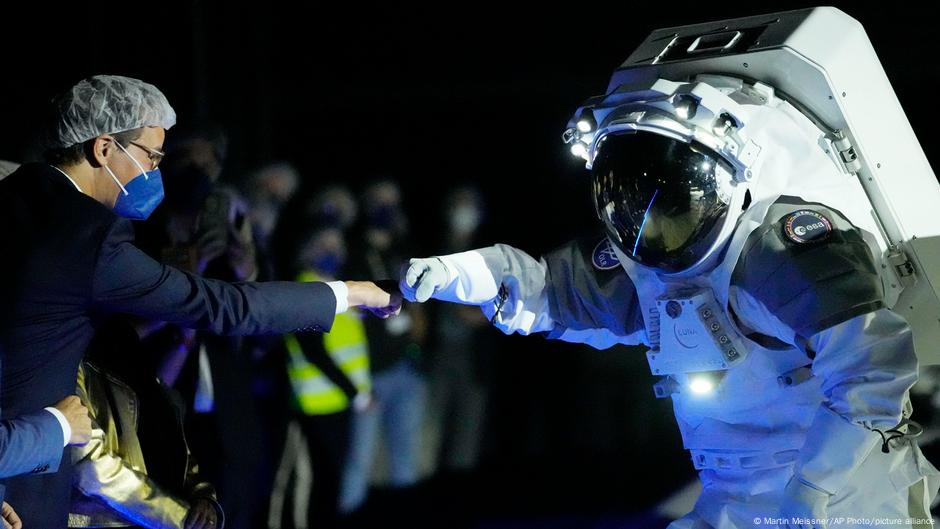- Dapatkan link
- X
- Aplikasi Lainnya
Getting to the moon takes a lot of small steps, like Europe's new LUNA training facility. But it's not there yet. Next step: a moon gravity simulator.

If you wanted to replicate the Moon here on Earth, you'd require these three key components:
a sandy material with a chemical composition like regolith (lunar soil) special lighting to mimic the angle of the sun a moon gravity simulator (the moon's gravity is one-sixth of the Earth's gravity)Plus, a gigantic enclosure to contain everything, similar to a large metallic shed.
When the German Aerospace Center (DLR) and the European Space Agency (ESA) presented their interpretation of the Moon — the LUNA Analog Facility In late September 2024, they had progressed two-thirds of the way toward depicting the moon's enigmatic terrain. However, one key component was still lacking.
The pitch-black environment was illuminated by a spotlight focused on two completely suited astronauts: Germany's Matthias Maurer and France's Thomas Pesquet.
Maurer and Pesquet marched across the hangar, with its 700 square meters (7,500 square foot) of artificial regolith, made from the volcanic soils of Italy's Mount Etna, the Eifel region in Germany and rocks from Norway.
Armed with long-handled scoops, a sample trolley, and accompanied by a robotic dog, the duo simulated exploring the mock lunar terrain before roughly 100 esteemed guests.
As they strolled along, the light beamed at a specific angle to mimic how the sun might impair an astronaut’s view when humanity returns to the moon, potentially as soon as this decade.
However, they walked — not bounced as seen in video clips from the 1969 Apollo 11 mission — because LUNA has no lunar gravity.
Gravity simulation: The missing component of the LUNA mystery
Against a cinematic soundtrack, Maurer and Pesquet demonstrated how they would collect samples and explore a crater on the real moon. It was a spectacle for the politicians and agency officials, who fist-bumped the astronauts for the TV cameras and their crews.
However, it seemed very terrestrial due to the lack of moonlike gravitational forces. This is an issue that the engineers haven't managed to resolve yet.

Previously, astronauts have utilized parabolic flights and swimming pools to mimic and feel the conditions of zero or microgravity.
During parabolic flights, specially modified jets simulate weightlessness by climbing to and diving from peak heights at approximately 45-degree inclines.
The astronaut training swim facilities are uniquely outfitted as well, with the trainees conducting simulated activities in their space suits.
However, none of these solutions would be feasible at the LUNA Analog Facility since it is located on solid ground.
Rather, engineers aim to create a "gravity offset system," according to Andrea Emanuele Maria Casini, an aerospace engineer overseeing the LUNA project.
"As if you were suspending the astronauts like marionettes," Casini stated.
Wires will be connected to the outside of the astronauts' space suits, probably exerting tension when they walk and holding them aloft as they leap.
The project remains in the prototyping stage. Until it becomes available, Casini concurred: LUNA is an extremely costly sandbox. However, ultimately they aim to test new technologies and train astronauts within a contained setting.
Casini stated, 'The magic occurs within.' He added that the landscape would assist the upcoming cohort of astronauts in returning to the moon.
Moreover, there’s potential for growth. Adjacent to the LUNA Analog Facility, you’ll find two extra components: a habitat simulator and a converted greenhouse originally part of the EDEN ISS project, designed to mimic crop growing in frigid extraterrestrial conditions.
Next to the primary hall, there’s an empty plot of land that could potentially serve as a site for a future "LUNA 2" mission or a simulated Mars training area.
The moon was brought down to Earth.
The LUNA Analog Facility has been under development for 12 years. Maurer, who has logged 177 days in orbit, He has been driving this idea since day one. He informed NewsBlog that the facility accurately depicted the conditions on the moon, despite lacking the gravity offloading system.
When I descend into the crater at the facility and am completely exposed to the sun’s rays, it blinds me," Maurer stated. Additionally, since he is inside the crater, the ridge casts everything ahead of him into shadows.
It's a stress test for astronauts, exposing them to the difficult and sometimes contrasting conditions they will encounter on the moon.
Another factor is the moon's regolith. "It's a major technical obstacle," said Maurer. "It destroys all electrical equipment, it gets into moving parts and blocks them, and it gets into the space suit. We can test [all that] here."

Links around the globe
LUNA can hook into mission control centers across the planet — from DLR in Cologne and the German Space Operations Center (GSOC) in Munich to NASA in Houston, US and the International Space Station.
That means simulations could be run remotely, with NASA astronauts, for example, guided through a mission simulation in Germany by their teams in the US.
When fully functional, the LUNA Analog Facility will stand as a totem of Europe's commitment to space, said ESA's special adviser for political affairs, Kai-Uwe Schrogl.
"[LUNA] provides credibility," Schrogl said. "You can talk a lot about going to the moon and beyond, but if you only have a few rockets or a lander on the drawing board, then you are not really credible. You need such a facility to show that you are serious."
In addition to supporting NASA's Artemis mission, Europe aims to reach the Moon by the 2030s with its independent initiatives. Establishing the LUNA Analog Facility represents just one of several smaller efforts toward this objective.
Edited by: Zulfikar Abbany
Author: Matthew Ward Agius
Komentar
Posting Komentar